This tribute by David Rainey, creator of this website and editor of the centenary tribute to Sidney Nolan Imagining in Excited Reverie, is a work of the imagination. It takes the form of an imaginary text supposedly written by Sidney Nolan himself, and of course not found among his papers after his death on 28 November 1992. Whilst obviously a work of fiction as to the words used and some opinions held, it is nevertheless largely based on fact and on Nolan’s own statements.1
It is posted on the 25th anniversary of his death.
A TRIBUTE BY DAVID RAINEY
Riverbending in Excited Reverie: Nolan’s Parables of Sunlight
I enjoy being here by the Thames at Whitehall, even if we’re much further away from the river itself than at Putney and there is no chance to go fossicking in the mud at low tide!
Putney and Whitehall are only six miles apart, but what a difference two bends in a river make. There are compensations here though. You’re right in the middle of things; the National just around the corner, Covent Garden ten minutes away and Festival Hall even closer across the river just over the bridge, all walking distance on a fine evening. The Academy too. I can even step out on the balcony and see Big Ben down to the right – if one really wants to.
Whitehall Court is convenient, but is not like Putney where we could walk down to our own piece of riverbank and watch old father Thames go marching along, down to the mighty sea. I hum the tune sometimes walking along the Embankment and imagine I’m Peter Dawson2 as I did when I was a boy.
I miss the studio at Deodar Road – those sweeping views from the big windows with the north light.
Turner is supposed to have uttered “the sun is God” just before he died. He took one final look at the Thames from his window, cried out “the sun is God”, lay back, and died. Not a bad way to go I reckon, but he was only a year older than I am now – far too early.
I’ve stood in front of his Cheyne Walk house in Chelsea. Today he’d see even less of the river than I do here. It’s not exactly a ‘walk’ anymore with a busy road in front, and the house is quite small in comparison with its neighbours. It stood out once and so did Turner – and he was never an Establishment man either. We almost share the same birthday – he’s one day after me. And his Chelsea house just one riverbend downstream from mine at Putney, both with floor to ceiling windows looking out to the Thames.
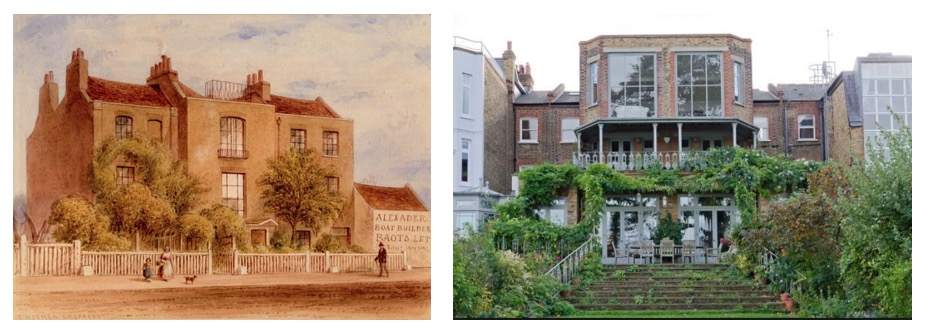
L. House of JMW Turner in Chelsea, by Thomas Hosmer Shepherd, c 1830 (Turner’s is the middle house. The footpath today is level with fence top); R. View from the riverbank of Nolan’s house in Deodar Road, Putney, photographed for sale of the property in 2013
Putney brings back other memories too, not so good ones, even sixteen years on. It is Cynthia’s anniversary in a week.3 Running over it all again in my mind, and I do that each year in spite of myself – not just her death, but everything else too – I decided I should try to write something about my life, something serious. For myself mainly, charting my course through life – just to see if I can. Can what? Chart a course through life, or can write about the course I’ve taken? At 75 it’s a bit too late for the former I fear, but it will be interesting to see how I go. Fifty years ago I used to write letters of quite some length, much more than my postcards and notebook jottings today. I’ve given myself a fortnight. It could be redemptive, an expiation.
I was thinking about it all just yesterday taking a stroll along the Embankment. A bleak wintery day, very still, the Thames a shimmering muddy grey umber – no Turner down there – and I remembered the old Yarra out at Heidelberg. They used to say it was the only river in the world that flowed upside down. I painted a figure once, standing by the Yarra looking down at it. My ‘Monk by the Sea’ after a fashion – but with a nude monk, and the sea more a creek.
There isn’t much of Friedrich’s romantic sublime about it however, particularly when my young brother drowned a few weeks after I painted it, right at the end of the war. Boy drowned at Cooktown on his way home from active service at a time when I was a deserter in hiding.4 I had to part with that painting as I couldn’t keep it. I found it too ominous, too prescient altogether.5 They say my father never got over Boy’s death. I’m sure he didn’t, and in one sense neither have I. His actual death, yes; but not the place I return to, thinking on it. It’s a damned, dark, muddied place and I try my best to avoid it – and usually do, except in the wee small hours.
I always thought it was Laurie Hope6 in that painting, but it couldn’t have been. The war ended in 1945 and I first met Laurie the time he and Barrie Reid7 came down one Christmas from Brisbane. That was before I left Heide for good, which was soon after my 30th birthday, so it must have been Christmas 1946. I should write about that Christmas and about leaving. Both are important because that Christmas led to my birthday resolution to leave, which, I have no doubt, cast the die for much of my life since.
I was right in the middle of painting the Kellys that Christmas. I’d just got back to Heide after being out at Stonygrad,8 Danila’s house in the bush at Warrandyte, while he was on a futile love mission to Sydney. I painted First Class Marksman at Stonygrad. There is a lot of me in Marksman. I told a curator in Canberra it was pivotal and she said she’d search for the key – her challenge.9 It was a turning point for me – I was taking aim at everything and everyone, myself included.10 He’s shooting forwards but looking backwards, as I was at that stage.
No one seems to have noticed that he’s shooting left-handed. Odd that, given Ned and I are both right-handed. Or that his trigger finger is performing a fine arabesque, with his left hand grabbing the stock from above rather than supporting it from below. Whether it’s Ned Kelly or Corporal Sidney Nolan V206559 (I remember the number), we’re neither of us painted as being what you’d call first class riflemen. And that drop of Ballarat blood.
Sunday11 didn’t like it; she detested it, which is probably why I’ve been able to buy it back. After just a few exhibitions she wouldn’t show it with the others, and she let Sweeney12 hang it when he lived in the old house. I didn’t ask questions, but I think Alistair McAlpine13 got it from Sweeney – and I got it back from Alistair. Otherwise it would be in with all the others she gave ‘with love’ to the National Gallery in Canberra.14 She wouldn’t give them back to me with love, or without it.
The other one she didn’t have was Ned Kelly at Stringy Bark Creek, the very first of the 4 x 3s. Turnbull15 bought it soon after I painted it. In 1946 he was organising an Arts Festival at the South Melbourne Town Hall and it was included.16

Sidney Nolan, Death of Sergeant Kennedy at Stringybark Creek, March 1946, collection NGA.
It was more Daunts Bend17 than Stringybark Creek – the Bend was full of those pointed tree stumps after my uncle and his gang cleared the timber with axes. I went there on holidays when I was a kid. Those two paintings missed out on Fred Williams’ restoration. The Reeds paid him to clean them up after their cats had been pissing all over them for years. Then they locked them away in a bank.
Laurie and Barrie arrived just before Christmas and with Barrie in particular I spent a lot of time around Heide and a few days at the Parkville loft. We walked and talked,18 we wrote poetry, and telling him the story of the previous six or seven years with the Reeds was cathartic. I wrote a poem for him, Prince on a Hill, with the words “They shall not be forever” .19
I am finding this very difficult. If I’m honest, it is surprisingly hard to write and think about them objectively, even 50 years later. Yet I feel quite able to write about Elizabeth.20 I don’t want to say much – not because I couldn’t, but rather because she was pretty much an innocent victim of the whole sorry saga. I’m not proud of walking away from a wife and a newborn daughter – even if it’s not strictly correct to say that I walked away after Amelda was born,21 rather Elizabeth didn’t return to our place from the hospital. It took me some time to learn exactly why.
Our early days together come to mind so easily – we stand on the shore of life. Literally.
St Kilda is my kitsch heaven with the pier, the foreshore, and our flat in Marli Place.
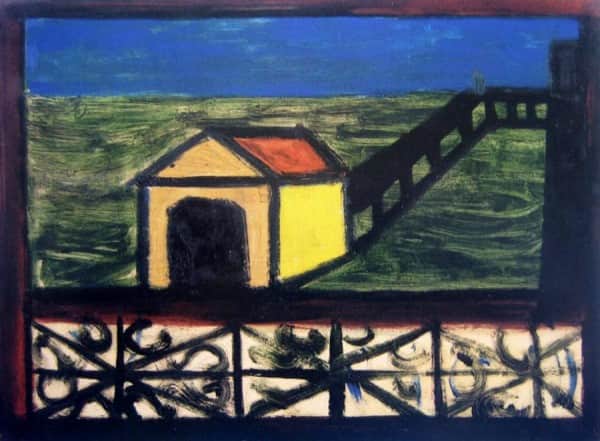
Sidney Nolan, St Kilda Pier, c. 1940
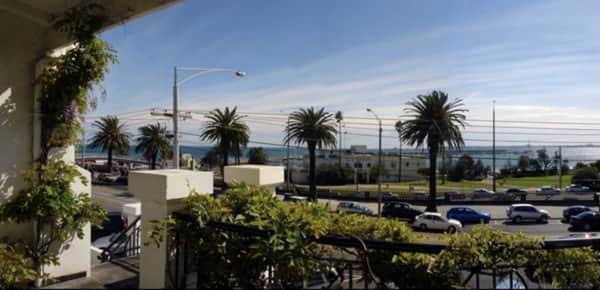
St Kilda Pier as seen today from the verandah of Marli Place
We have our little arched bridge below the Esplanade. I hope one day to write a book in which the poetry celebrates instead of castigates,22 and is more like what I thought about at eighteen standing by that bridge.23
We marry on the spur of the moment, tell no one, just Allanah24 there and a couple of witnesses. My fateful visit to Murdoch chasing funds which leads to Burdett, to Bell, to a certain lawyer in Collins Street, and soon to Heidelberg.25 And then poverty at Ocean Grove and Elizabeth unable to understand or take it.26 I can see that now, but couldn’t then, couldn’t for a long long time. The split was probably inevitable given what happened – along with the interventions of some.
I did try to patch things up a couple of times, but didn’t really get past her parent’s front door. It certainly wasn’t Elizabeth’s fault, but perhaps not entirely mine. I don’t know, I still think about it and find it a burden on my conscience – less because we fell apart, which happens all the time, but because of what it all led to. What it led to for me that is, not for Elizabeth. It led me to Heide and the Reeds. Perhaps I’ll write about that later. It was a night-mare period of my life.27
The situation at Heide was hopeless by the time of my birthday in April after that Christmas. Barrie had been pestering me to leave Melbourne and come north and I made up my mind with hardly a second thought. I’m too impulsive perhaps, but if it works it works. Soon after arriving in Brisbane, I visited Fraser Island briefly with Barrie, but I needed to get back again after those first few mid-winter days. Jack McKinney and Judith Wright28 were going over for the October long weekend and said I could join them and stay on. Returning was, as it so rarely is, a real return and in the space of two days there I once again got caught up in its spell. Most of all this time, I was affected by the clearness of the water in the lakes and creeks. In one of the lakes it is impossible to tell where the water meets the white sand. Your feet find themselves in water while your eyesight swears you are still walking on sand. This is the kind of purity one sometimes wishes for painting. There are paintings I know in the past which give one this feeling but they are rare. A drawing of Leonardo’s of a woman by a waterfall has it perhaps more than anything I know.
It is this visual precision which I look for so much in nature now. It is under one’s eyes all the time but somehow the inner thoughts and attitudes must be equally refined and precise before one is aware of the unfolding in the astride world. This relationship and interaction between the two seems to me the field in which a painter works, at least that is what I feel is possible for a painter. It is not often that one is able to realise this balance. Probably it does not matter from which end you start as long as the balance is reached.29
Judith Wright told me about the blacks and Woongoolbver Creek.30 It was a woman’s place, no men. The water’s so pure they’d give birth there she said, a place of ritual purification. The creek was next to the house at Central Station where I stayed. I had the whole place to myself for a few days.
I can still shut my eyes and imagine it. Even here by the Thames in winter. It’s hot, stinking hot, with that steamy Brisbane heat that turns clouds green and fills them with hail. I stripped off beside the creek, not for cooling really but rather for cleansing, to let those Woongoolbver waters wash over me and half a dozen years of guilt – about Elizabeth and Amelda, about the whole Heide thing, about the war, about deserting, about Boy’s death, my father’s shame and grief, my mother’s sorrow. Could this be purification I wondered.
I lie face down, breath held, arms ourstretched. Underwater eyes fix on the criss-cross pattern of sticks on the creek bed. They seem both far away and a foot away, the water is so clear – difficult to capture that with a brush. I’m adrift in an infinity of time and space. All of a sudden, head still submerged, an involuntary gasp for air fills lungs with water. So strange a feeling – most curious. I wonder if this is like Boy’s drowning …. an easeful death?
Then just as suddenly I come to; hair matted like a mop, gasping and spluttering animal-like, on hands and knees in the shallow water, reaching out with one arm towards this thing …. this dingo, if dingo it is, standing there seeming to mimick me. Stock still in the stream, its head a mass of dark hair, the creature extends a limb towards me, seemingly in welcome …. beseechingly …. beckoning ….
It etches the mind and is there forever.
Along with Eliza Fraser of course. I was full of her at the time and being honest, have been ever since to some extent. Something about her story … even more so with Cynthia’s telegram.31 Things go full circle. So Eliza is in that painting too.32 In fact I cut it down for the Whitechapel show, gave it a border (that didn’t really work), and called it Mrs Fraser.
And soon enough in my mind’s eye it became Sunday Reed, but I won’t talk about her much. Close by here is the Monk House place of Virginia Woolf and Leonard, and in Kent there’s Sissinghurst and Knole – all those characters that influenced Sunday and John Reed. All gone now for better or worse, but they all seemed at odds with the planet .… mad, in other words.33
I took one of the Reeds’ Sewanee Reviews34 to Fraser Island and it was in that book I first read Cal Lowell;35 not his poems, but his review of books by Dylan Thomas and Carlos Williams. He mentioned Thomas’s Poem in October which has great significance for me, and quoted from Fern Hill with its magnificent last lines “Time held me green and dying / Though I sang in my chains like the sea” which echoed through my days there at the beginning – describing so well my situation on a few fronts, and with that constant drum roll, even inland, of sea on shore. And it was there I first read of the Paterson poem of Williams that seemed to give a hint of something indigenous at last coming from America,36 with its narrative of the river which symbolises thought rising beside the woman mountain, flowing through the man city of Paterson, over the Passaic Falls where lovers drown and are carried helplessly to the sea. Very Eliot.37 I do not know much about gods, Eliot says, but I think that the river is a strong brown god. The river is within us, but the sea is all around us – and the sea, he reckons, has many voices, many gods and many voices.
Looking back today, that old Sewanee seems prophetic. Twenty years later I was working with Cal illustrating his books. We clicked. He said the bridge from ancient Rome to his America was made by my drawings and hoped his lines may throw some light on mine. Ut pictura poesis. These last lines from The Ruins of Time in his book Near the Ocean still resonate: “those brilliant hours that wore away our days / our days that ate into eternity,”.
But so too Cal’s working of Baudelaire’s Voyage: “give us visions to stretch our minds like sails, / the blue, exotic shoreline of your dream!”

Sidney Nolan, the blue, exotic shoreline of your dream, 1968, illustration for Lowell’s book Near the Ocean
Painters need visions that stretch our minds like sails. All artists need this of course, but we need visions beyond vision. Mere vision isn’t enough. Visions beyond vision only come with hard work and patience, when you get the balance right between finely honed inner thoughts and attitudes on the one hand and precise awareness of the unfolding in the astride world on the other. When that happens, that purity of vision – and I can wait months for it – then, as Eliot puts it in another context …. then the tongues of flames are in-folded into the crowned knot of fire, and the fire and the rose are one. Then I can paint.38 It is, I suppose, dreaming standing up.39
Cal’s “the blue exotic shoreline of your dream” is the best version of these Baudelaire lines I’m aware of. I don’t know any other that includes shoreline. ‘Shoreline’ is quite evocative: St Kilda, Fraser, Hydra, Gallipoli, the Antarctic, the Yarra, the Thames, Friedrich’s monk and the sublime. Perhaps when liminal shorelines meet sub-liminal sublimes, it’s then the fire and the rose are one. It’s then when one paints best!
After five months in Queensland I came down to Sydney just before the New Year, and stayed at Alannah’s studio. We talked about my early days with Elizabeth and the break-up. Those conversations brought it all back in spades, particularly reliving the time I met Elizabeth’s mother on the tram and learned how John Reed had spoken to Elizabeth when I was trying to sort myself out on a bike ride in Tasmania. He told her to come and live at Heide, they could help raise Amelda, because I’d never reach my full potential with just her at my side.40 God only knows what else he told her. Remembering all that again after six years convinced me I had to draw the curtains on that episode of my life.
When I married Cynthia41 three months later, I couldn’t have imagined how firmly shut those curtains would become.
Looking back now to those years I must admit to being wet around the ears and not really knowing which way was up – but I was not the first young buck to be swept up in the allure of the older woman, in fact I made a practice of it one way or another for 35 years! Perhaps Elizabeth and I were both better off in the long run – certainly no one could have managed my career as well as Cynthia did, and manage me to boot. Nevertheless, I’ve held a concern for Elizabeth to this day, and I’m pleased she has had a good life. She’s retired now to near Fraser Island I’m told – it is indeed a small world!
I’ve been writing this now for a week. Today is Cynthia’s anniversary – sixteen years ago. Time to write about my last birthday at Heide where I’d been, one way or another, for eight years.

Christmas 1946 at Heide. From left: Sidney Nolan, Sunday Reed, John Sinclair and John Reed. Photo: Albert Tucker
She was one for the grand, the ritual occasion was Sunday Reed. My 30th birthday she’d planned as such.42 But I’d woken earlier than usual, dressed quickly, tiptoed to the big table and started on that last Kelly. By the time they rose I had it well under way. I was calling it Watchtower and modelled it on a photo of a western town in a magazine with a chap on a lookout who looked a bit like me.43 I was certainly on the lookout to get out, though even today I have to admit it was Sunday who had the green fingers. Sunday could spot an artist.44

L. Sidney Nolan, The watch tower, July 1947,collection NGA; R. Longreach, Queensland, in “Walkabout Magazine”, March 1947
I was working fast – faster than usual – the board laid out on the old table. I knew she was there at the door, but I didn’t say anything or turn around for a good twenty minutes. Then I suddenly swung round on one heel, told her I’d let her see it later and stacked it face in against the wall. “When it’s finished” I told her, “I’ve got to draw in a figure. It’s Watchtower …. the last of them.”45
I told her she wouldn’t like it, that it was a bit on the dark and gloomy side. “Don’t worry” she said, “I’ve got you a birthday present. We’ll go down to the riverbank and read it together,” and we sat on the bank where I used to run down and dive in.
We gazed down into the dull, brown muddied old Yarra and it brought to mind the river where my father took me fishing when I was little, the Goulburn up at Toolamba and the river’s big sweep round Daunt’s Bend. Suddenly though I thought of Boy’s final dive into his last river at Cooktown with its mud and mangroves. He didn’t see twenty one, let alone thirty.
She gave me her present, Dylan Thomas’ book of poems Deaths and Entrances, and we read Poem in October.46
It was my thirtieth year to heaven
Woke to my hearing from harbour and neighbour wood
And the mussel pooled and the heron
Priested shore
Woke to my hearing! I’m not sure about my hearing, but those lines woke me to the realisation that I had to leave, get away from there – and that I must tell her.
And when Thomas speaks of his childhood memories, his rekindled mine:
And I saw in the turning so clearly a child’s
Forgotten mornings when he walked with his mother
Through the parables
Of sunlight
And the legends of the green chapels
I thought of how my father lived at Shepparton when a boy and how he would take us back for holidays at Toolamba.
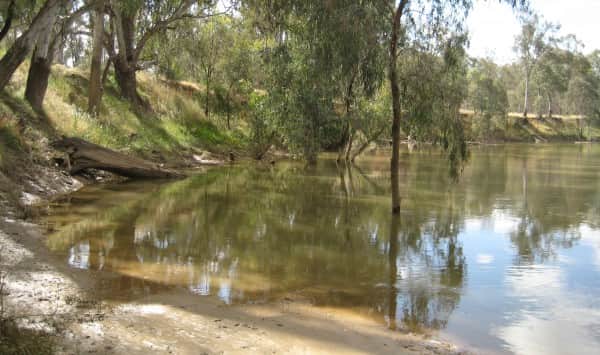
Daunt’s Bend, Goulburn River at Toolamba, Victoria. Photo by author
We had our special spot – a bend in the river – where we’d fish for Murray cod. It was like that, just like that – parables of sunlight and legends of green chapels. It fits perfectly. Even down to Uncle Bill Nolan, who was quite a legend with an axe.
These were my childhood’s “forgotten mornings.” It was along this river that I was brought when I was about, I suppose about six weeks old. And I was fed by my mother … in a log cabin … I still think about my mother, the river is still there, the river runs.47 The light is transcendental. It completely defies description … you can only be part of it, you can only be within it.
These were the woods the river and sea
Where a boy
In the listening
Summertime of the dead whispered the truth of his joy
To the trees and the stones and the fish in the tide.
And the mystery
Sang alive
Still in the water ……
I sat there with Sunday for ages, stock still, saying nothing, just gazing into the muddy waters, and eventually we headed back up to the house. And I told her I was leaving …. and as we walked slowly up the hill she snatched back the book and said I didn’t deserve it, she was keeping it, I’d betrayed her. I told her to keep it, I would paint it … that I would paint those parables of sunlight that had suddenly appeared for me. Paint it, yes – but not merely like I had just described it, but as I SAW it – but even more than that …. paint it as if I were part of it, as if I was integral with it, as if I could become the landscape. I would paint it as if I was sitting in the middle of a magic lantern cylinder with the images of the bank all around me. That is exactly how the river sees it. That is how to paint parables of sunlight and legends of green chapels!
And I did paint it, almost twenty years later, for my father, and for Boy … and neither of them ever saw it.48 My father died two days before my birthday in 1965, just a few weeks before Riverbend was first hung at David Jones up in Sydney. He never saw it, never saw it. But it’s still here and so is the river, and so is he and Boy, and me … all of us … all of us better than the worst things we’ve done – at least I hope so. People see Sergeant Scanlan in the figure in the river – and perhaps he is if all you do is focus on Kelly – but it’s really my dad, it’s my brother, it’s me, it’s you, its Everyman in that strong brown Goulburn god heading for the sea – and the sea has many voices, many gods and many voices.
My father visited us in London not long before he died and I told him I’d paint Daunt’s Bend for him; said I wanted to go there again, just with him and then I’d paint it, for him. He said he’d like that, but I’d better get a move on – and not too big if it was going to hang in the lounge, and not too fancy if it was going to hang anywhere, and not with bloody Ned Kelly behind every tree.49
I did get to Toolamba again, but not with him. I returned to Sydney from the Antarctic in early 1964 and drove across to Adelaide with Tass Drysdale50 and Hal Missingham51 for the Festival. We headed across from Violet Town and I showed them our big river bend. I showed them the exact spot where we used to fish. Walking down to the very edge I forget how the baked mud crust could slip on the soft mud beneath like a banana skin on a kitchen floor and I went head over heels in the mud. Most undignified, much hilarity from the others – but I don’t think of it as a fall from grace, rather into grace, because it reminded me how the river sees its bend.
My father seemed disappointed when I told him I’d already been up to Toolamba. He just nodded and said it was OK. I can still see that nod and it takes me back to Cooktown and the listening summertime of the dead – especially when I can’t sleep. But slowly over the next nine months, often lying awake, it all began to gel in my mind.
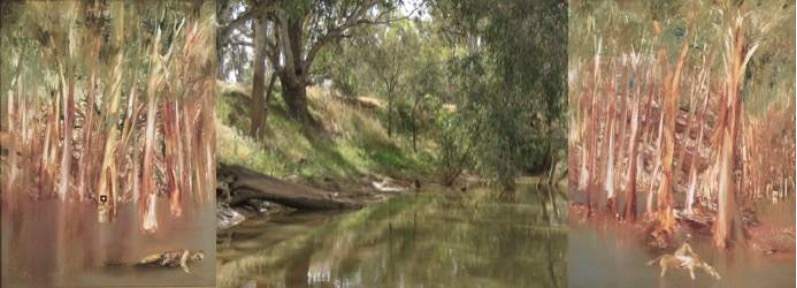
Panels 2 and 3 of Nolan’s Riverbend bookend a photo of Daunt’s Bend, Toolamba on the Goulburn River where Nolan fished with his father.
I painted it at Putney that Christmas, nine big canvasses, and I knew I had nailed that heavenly transcendental light. I did it in three sessions really … mesmerising sessions they were …. I felt transported to another place …. another plane …. another dimension. It was at once transformative, transforming, transcending, and transcendental. A feeling that doesn’t come often when one paints – that feeling when the fire and the rose are one.

Sidney Nolan, Riverbend, 1964-65, collection ANU, Drill Hall Gallery, Canberra. Note that the size of the middle seven panels has been progressively reduced in this presentation.
I like opening out the cover of that old AGNSW catalogue,52 folding it round in a circle outside-in and forming a cylinder to give you one big continuous panorama. You’re inside the magic lantern.

Detail, cover of catalogue, “Sidney Nolan retrospective exhibition: paintings from 1937 to 1967”, 1967, AGNSW
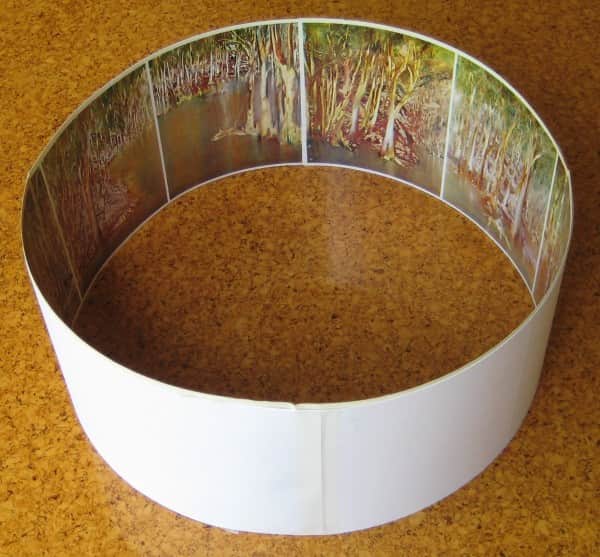
Simulated magic lantern of Sidney Nolan’s Riverbend
John Reed wrote a review which made me chuckle. Ever the discrete perspicacious lawyer John, but then, as he wrote to me years later, a perspicacity and discretion that once served me well – or was it a certain tough resilience he mentioned?53 He thinks Riverbend doesn’t yield up its secrets, that it hasn’t been fulfilled and only presents its surface.54 Typical John Reed, but it’s not meant to yield up its secrets – the mystery sings alive, still in the water.
‘Tis mystery all. We are all a mystery, most of all to ourselves I suspect. Our self-protection mechanism. I once told Bert Tucker55 that I wasn’t a painter, I was a businessman. Poor Bert, that shocked the wits out of him.56 He thought I was putting him on, but he must have re-thought it because when he painted his series “Faces I have Met”57 – all the crowd from those old Melbourne days – he had me looking very business-like.
Also somewhat fraught in another one. It was soon after Cynthia’s death, and he captured me all too well.
“The sun is God” Turner said looking out on the Thames. I wonder. I’m not at all sure he was right. Eliot is probably closer to the mark with his river as a strong brown god, and Eliot knew a good river line when he saw one. His Waste Land borrows Spenser’s “Sweet Thames, run softly, till I end my song.” Now there’s something to contemplate. Not much of Turner’s transcendent sun god in evidence here yesterday and today, whereas Eliot’s strong brown river god is always around – and immanence is surely one essence of the divine, Kierkegaard notwithstanding.58
I’ve thought a good deal about Turner since I was elected to the Royal Academy last year. I wonder what my father would have made of all that, and my knighthood in 1981 … Sir Sidney no less! He thought the OBE in 1964 pretentious, and he’d probably have thought an Australian gong better than my British one, and reckoned I got it by foul means. Even if I did betray my working class origins, I really accepted it for my mother. I told Xavier Herbert that recently, just before he died, and he called me a bastard and reminded me she’d been dead a dozen years – which I said should make no difference.59
Funny lot the British in many ways. Take my Order of Merit in 1983. When Graham Green was a spy, Philby was his minder and they continued friends after Philby defected. He was still made OM and the Queen must have been totally aware of his position … and also aware of mine. So it makes England quite an interesting place in spite of its defects.60 I was totally confused about the honour, and quite uncertain as to what I was expected to do about it or how I should act.61
But its not only the British one wonders about. An editorial in an Australian paper was headed ‘Distinction for a genius’ or something like that and pointed out, that in spite of fame, I’d fallen foul of the notorious tall-poppy syndrome which is a regrettable successor to cultural cringe. That worries me greatly.62 However, unfortunately it is true. I believe that even Kym Bonython63 was bandying it about that I refused an OM a few years earlier because I wanted the less prestigious knighthood in order to be known as Sir Sidney.64 That from a person who insisted that his portrait should include his racing car driving cap.65 Oh, the trials of an old Adelaide family!
I’ve always admired Turner, and we have more in common than one would think. Sunday Reed and I would talk about him and Cezanne, and I used to reckon that between them there is no saying what was possible in rendering myth.66 I told Kenneth Clark I thought Turner a wizard technically, and otherwise, and wished I had his secret.67 It was the Antarctic convinced me about Turner – only when I saw the Antarctic, did I first really see him.
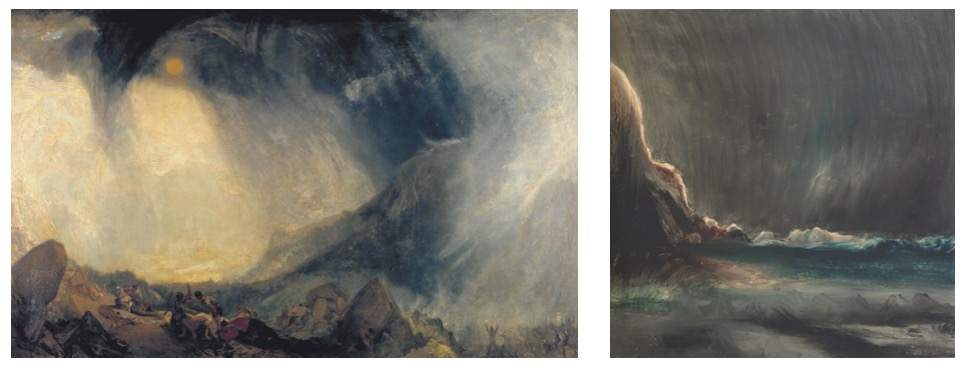
left: J.M.W. Turner, Snow Storm: Hannibal and his Army Crossing the Alps, 1812, Tate Britain; right: Sidney Nolan, Bay, 1964, private collection, UK
I sometimes wonder what Eliot would have made of the Antarctic. Would he still have thought the river a strong brown god? Very little brown down there. Perhaps instead he’d have written: I do not know much about gods, but I think that the river is an ice blue god. And no matter how fixed, how frozen, the glacier still flows – as I’m sure we should ourselves. The thing you come to realise is that nothing is fixed – that everything keeps being transformed – and you have to sense where paradise is in the process.68
Turning thirty was significant for me. I’ll never forget reading Thomas’ Poem in October that first time. It hit me like a sledgehammer – O may my heart’s truth still be sung on this high hill in a year’s turning. Well, yes, and amen to that. But turning 75 several months ago was more significant. It didn’t hit me like a sledgehammer, rather I discovered I could no longer use a sledgehammer. Down at the Rodd, and I swung one a couple of times and put it down quickly to check no one was watching. We always say, all of us, that we can’t last for ever, but deep down we never really believe it. It’s not that so much, rather we don’t identify with the fact of advancing years, don’t live the reality. We still think, without thinking, of our fathers as old men and ourselves as young chaps. Until one day we actually do believe what it is we see in the mirror – or we discover we can no longer swing a sledgehammer. I lay there not sleeping the night of my 75th birthday – and it is true what they say: everyone knows the truth at 3 in the morning.
Hence, I suppose, this missive. And hence too, my unfortunate confession to Mary69 the other day when I was feeling a trifle off colour, that I was thinking this way. She is much younger of course, and didn’t take at all kindly to my suggestion that when the time came, I should join Karl Marx in Highgate along with its clutch of fellow Academicians; and that if she did insist on a dignified memorial service at some later stage – then I would like St James’ in Piccadilly where we’d once sat in a pew and held hands. I even insisted that if the recessional were not Jerusalem I would have something to say about it. And that, as she knows so well from my anger when I hear it sung on telly, would be that its familiar setting by Parry, and words by Blake – particularly the very last “in England’s green and pleasant land” – have led to it becoming today’s flag waving, chest thumping, football fevering anthem.
All of which is to greatly mistake Blake’s revolutionary intent 200 years ago when he wrote And did those feet in ancient time. The “dark satanic mills” were real for Blake, and so was his vow to not cease from mental fight, nor let sword sleep in his hand: Till he had built Jerusalem, in England’s green & pleasant land. Blake is a hero. He was acquitted of charges of assault and uttering seditious and treasonable expressions against the King – “Damn the king” he said, “the soldiers are all slaves.” Well I protested the soldier’s lot too. That is why I gave Ern Malley a shell thrust in his face and I made him half a carcass to show he is half ghost and half what happens when you go to the war and you do come back.70
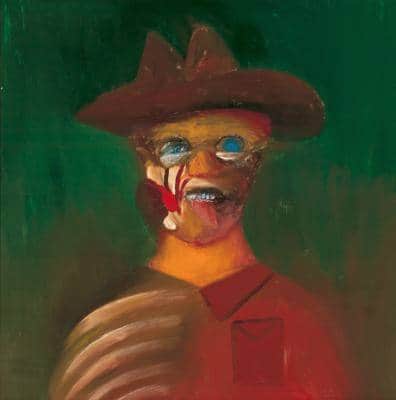
Sidney Nolan, Ern Malley, 1973, collection Art Gallery of South Australia
I’ve never been a communist, but I was always a believer in the heightened consciousness of the proletariat, and I feel that still – because, what else?71 As Diderot says “One class devours another in society”. Like natural selection.72 Some people are very sympathetic to the left and that is their position until they’re called up, and then into the army and their politics turn around quite quickly. All you can say is that they’re lost to the fold.73 Like McAuley who co-wrote the Ern Malley poems. One of the poems has the lines “What would you have me do? Go to the wars? There’s damned deceit in these wounds.”74 In 1944 those words hit close to home for me. Many years later I painted half a dozen Malley portraits in a day, one of them with my corporal stripes, and I wrote those words on the back.
Whitlam wants me to paint the whole thing of the Dismissal and I will – when he comes clean. But he won’t quite come clean and I can guess why, because of the CIA involvement. Clark75 said to me once that you could not paint history until everyone is dead. Well they are beginning to be, him nine years ago, and last year John Kerr and then de Lisle who I thought was the go between Kerr and the Queen. Kerr died the day before Archbishop Lefebre who you might call a fascist. Into what category should one put Kerr with his Council of Civil Liberties and their dubious sponsors? So all the characters in the plot are now dead, almost, and the whole thing ready to paint. I promised Whitlam I’d paint the history of the whole affair, and I will do to Kerr the opposite of what I did for Kelly.76
I’ve digressed, but all that is part of the course I’ve charted. At least I hope it is.
At Putney, Mick Stow77 and I would chart a course along the Thames embankment in Wandsworth Park and talk about rivers and seas and their meaning.78 He saw the sea from a landed perspective, like Friedrich’s Monk. He reckoned the land was key, without land there was no river. That was the land’s meaning – he’d write a poem explaining. No, I said, land and rivers and sea are all defined by the liminal; without a riverbank it is all land, and it is either all land or all sea without a shore. I always link that particular discussion with the last words of his novella To the Islands spoken by Heriot as he looks out over the Arafura Sea to the Aboriginal islands of the dead. “‘My soul,’ he whispered, over the sea-surge, ‘my soul is a strange country.’” What an unforgettable utterance. I cannot imagine how, a mere 20 year old, he managed to get so convincingly inside Heriot’s ageing 60 year old head. He told me once he saw in me a lot of Heriot – an observation I’d already made myself with a disconcerting mixture of both concern and satisfaction. Did Heriot gaze to the islands from a blue exotic shoreline I wonder. Will I?
Mick wrote The Land’s Meaning for me. He says the love of man is a weed of the waste places, that one may think of it as the spinifex of dry souls. And I have not, perhaps it is true, made the trek to the difficult country where it is said to grow. But is empire the mastery of silence alone, as he implies? Is God but a man unwounded in his loneliness? I wonder. Like the one Mick says has returned from the difficult country, I was bushed for forty years. Thinking on his poem thirty years on, I wonder whether without knowing it, I have come to that bloke all alone like a kurrajong tree. Would I have said to him: ‘Mate – I don’t need to know your name – Let me camp in your shade, let me sleep, till the sun goes down.’? Probably not, because for too long I’ve been coming to terms with having camped in a certain shade for eight long years.79
They were a mixed bag, those lost years of mine. They were the best of times but also the worst, and I have come to realise I dwell too much on that period. I’m not sure they were defining times or delineating times. They simply just were. They were there, they happened, and like all other time in between, they bring one to this present moment in time. That’s all, but it is this moment we can do something with.
Sunday could never see the logic of why I left. Well I didn’t want to go either – but I couldn’t see the logic of staying. She wanted it both ways, and so did John … everyone wanted something that was impossible, which is natural for human beings, but they don’t usually get it. Except I’ve got it now. I think.80
Amelda has been a vital part of my life now for more than 30 years and I’ve known the grandkids all their lives. When I’m in Melbourne we lunch and walk and talk, and when I’m here in London there are long phone calls, and she keeps the postcards I send. I love the way she calls me ‘Sid’, but when it’s ‘father’ I know I’m in trouble. It is hard to believe she has turned fifty. I have a delightful image of her at St Kilda pier like a Japanese print.81
And what do I say about Mary? It seems I’ve known her for ever. Is 50 years forever? It must be almost that long since Max Harris wrote his poem for her in the first Angry Penguin we did in Melbourne – he subtitled it “for Mary Boyd. Verweile doch, du bist so schön.“82 The Faustian bargain – just linger a while, you are so beautiful. And she was. She’d bring me food parcels when I was in hiding and on the run from the Army. We talk about it sometimes – our own Little Gidding moment. “And the end of all our exploring will be to arrive where we started and know the place for the first time.” Du bist so schön: she was certainly beautiful.
After we married, Mary wanted me to ring Sunday. When we were in Melbourne for my 60th retrospective she convinced me to drive her out to Heidelberg, but even thirty years on I didn’t want to meet them again. I parked up on the road near the old house and stayed in the car, and pondered why I was so reluctant to revisit that past. I better understood my feelings later that night. She had asked Mary to prevail upon me to ring her and so I did.83 I rang her up and it was a very difficult phone call. Apparently she went away and just burnt all her letters to me.84 I finally went to Heide five years later to see the Kellys hung in the new gallery. She and John had died a few months earlier.
Eventually though, time heals – and we self-heal too as we better discover our own real selves. Today, ten years later, it’s a strange feeling because it’s the opposite of Patrick White85 in a way. Now I feel tremendous affection for them all. Yes, I feel that for all.86
Brett Whiteley87 … he’s been dead four or five months now. Too young – he was twenty years younger than me – a shame, a waste. I felt an improbable attraction towards him going back to that first Whitechapel show.88 At the opening he made some snide remarks about my international successes and it came as a shock being made to feel that all I had been doing was to hold up the game and stop real Australian artists like him from coming through.89 He got under my skin then, but I came to see in him a younger me – too confident by half, both of us. But if you want to fly, then jump up and bloody well fly. On with the dream!90 I banged on about that once when we were on Hydra, and I suppose a Greek island is a pretty good place to jump up and bloody well fly. It has after all been done there before. I first painted Icarus fifty years ago for the Ballets Russes in Melbourne. It all seemed like a dream then, but fifteen years later Hydra gave the blue exotic shoreline of my dream another perspective. That blue sea is another parable of sunlight; all around us, with many voices and many gods.
Thanks to Alan Moorehead,91 whom I met on Hydra, I traced the shoreline of my own dream to Gallipoli and later to the Antarctic.
That exotic blue of the Gallipoli shoreline belies its history. It’s the blue of the sea at Gallipoli you’d call exotic, not its shoreline and not its depths. In both of those there is an undercurrent – through both of them flows a dark river – and I’m not at all sure I’m very comfortable with this particular strong brown god. I made an odd, a disturbing, connection between my brother’s war service and these Gallipoli shores. Boy served as a sapper in the Army’s small ships company on board a couple of makeshift vessels transporting troops to mop up Japanese remnants in New Guinea. One was an old three mast schooner, and the other would you believe, an old refitted car ferry from the Hawkesbury River at Peat’s Crossing north of Sydney.92 He was aboard that old ferry in Cooktown when he died.
And it occurred to me, who pays the Ferryman? I pondered that question and painted an answer.
Gallipoli was painted not long before Riverbend and it is a complicated painting of a complicated answer to a complicated question. Boy is there “by dark Styx’s gloomy strand”93 with an old plumed Digger’s hat; I’ve given him my corporal stripes and he’s carrying our father who is ailing, but will in fact live two more years; I’m there to be recognised and a dozen other dead and living dead. Let people make of it what they will – I’ve never been entirely sure.94
When the War Memorial wrote enquiring about exhibiting the Gallipoli paintings, I gave them 250 – the lot – in memory of my brother.95 But not just him – my father, myself …. Everyman. My tribute to all the poor sods who have answered the politicians’ King and Country calls to go to the wars. There’s the real deceit! New borders drawn on maps in their blood, and history yet again redefined by dispossession. There was some little sense of closure for me in painting Gallipoli – even if the exotic blue is rather patchy.
I once discussed the colour blue with Whiteley.96 He asked me why didn’t I go to the Antarctic, and being well trained I eventually did.97 He was right – it is quite an extraordinary place.98 Antarctica gives another dimension entirely to the blue exotic shorelines of dreams. There, where glaciers cascade into ice chocked seas, where the shoreline can appear a desert wilderness of blue ice under an ominous flat grey sky, the sublime surely merges with the subliminal. One can only imagine what Turner and Friedrich would have painted had they seen what I saw during that week with Moorehead.
I painted a portrait of Whiteley some time ago – successfully I think, a spray painting, jay-blue almost – but I’m not sure whether he liked it.
He and I talked once about Hopkins and his poem Wreck of the Deutschland and I told him that Mick Stow’s house in Harwich ran down to the quay where the nuns’ bodies were brought ashore.99 Did the nuns, Whiteley wondered, meet the Master of jay-blue heaven and belled fire? I said that sounded more like the Antarctic than Harwich and he asked what then I considered the wonders of the world. I answered in a poem:
no it was not these
it was the jar
of the cart
my father drove me in,
the Antarctic mist
on the many fleeces
Sweet heaven in pieces.100
Sweet heaven in pieces. Who knows what heaven is, but whatever it is, perhaps it is in pieces …. pieces of pure goodness one might hope. A haven perhaps? No, havens are here. Once, discussing Hopkins, Mick and I argued the toss about this.101 He likes Hopkins.
And I have asked to be
Where no storms come,
Where the green swell is in the havens dumb,
And out of the swing of the sea.102
I’m not at all sure I want to be out of the swing of the sea. I enjoy it too much. This century for example: Kenneth Clark said it is a bad century for Art and I think he was embarrassed by it. Picasso was angry with it. Joyce thought its language contemptible. Yeats disdained it and its wars. No. I have enjoyed the century.103
Eliot says it all best in Four Quartets:
And all shall be well and
All manner of thing shall be well
But that’s not Eliot, he borrowed it from Julian of Norwich – which makes me wonder if there’s not something special about those East Anglia shores. Who is the monk by that sea? Mick at Harwich, Ben104 at Aldeburgh, Dame Julian at Norwich? Perhaps there’s a monk by every sea, by every river bank and riverbend – on Fraser Island, on the Yarra, on the Thames, at Daunt’s Bend. Perhaps we’re each our own monk by our own seas and rivers.
Ah well …. all manner of thing shall be well … at least one hopes so.
This has all been difficult because I fear I’m a very private man at the heart of things. I’ve never talked it very much, I’ve painted it. I’d rather paint what I have to say than say what I have to say.105 I’ve hardly mentioned my mother, and I’ve still to write about Cynthia, and Jinx. Perhaps Barrie Reid. And my dark years, perhaps Ballarat. Perhaps the sonnets. Perhaps Oedipus.
Another day.
I’d better get to bed. I’m checking some Turners at the Tate tomorrow and I promised Mary I wouldn’t stay up late. I do feel rather tired.
EPILOGUE
Sidney Nolan died the following day, 28 November 1992, in his Whitehall Court apartment soon after returning from a visit to the Tate. As Lady Nolan recounted: “It was so quick. He was sitting on the bed, talking about something. We had even considered going out, but he was feeling slightly off-colour. Suddenly he stopped mid-sentence and crashed back on his pillow. … It was over. He was not ready to die.”106
His funeral service moved from St Martin-in-the-Fields beside the National Gallery to Highgate Cemetery where he is buried just 70 metres from Karl Marx. A memorial service in St James’s Piccadilly on 22 April 1993, his 76th birthday, concluded with Jerusalem. Following her death on 6 April 2016, Mary Nolan joined him in their shared grave on what would have been his 99th birthday.
END NOTES
- The text follows known and acknowledged primary and secondary sources of information which are referenced as endnotes, however some central matters are entirely the creation of the writer. Nolan’s utterances are of course imagined, except for passages borrowed from his own words or from the reported words of others of the time; these are acknowledged in the endnotes. As for imaginings, I know of no suggestion in the literature of any particular activities on Nolan’s 30th birthday; nor am I aware of any comments made by Nolan along the lines suggested here regarding his paintings First Class Marksman, Mrs Fraser (as it is now known) and Gallipoli. These, and any other excursions of the imagination, are believed not to conflict with his own actions, attitudes or opinions. May the imaginings not be devoid of plausibility. All are acknowledged in the endnotes.
- Peter Dawson (1882-1961) was an Australian bass-baritone and popular recording artist, particularly of rousing British ballads like Old Father Thames. My thanks to Brian Adams for reminding me of the song.
- Nolan’s second wife Cynthia suicided on 24 November 1976. They had arranged to meet for tea at Fortnum & Mason as was their custom, but instead she booked into a hotel where she died from an overdose of barbiturate. Nolan returned to Deodar Road to find the cryptic telegram “Off to the Orkneys in small stages.” He learned of her death next morning, and would discover he was not a beneficiary under the will and that the house, which had been in her name, had been sold.
- The youngest Nolan sibling, Sapper Raymond John Nolan VX146279, nicknamed ‘Boy’ within the family, was accidentally drowned in Cooktown Harbour on 20 July 1945, a fortnight short of his 21st birthday. Corporal Sidney Robert Nolan V206559 went AWL on 20 August 1944 when he failed to return to barracks in Melbourne from one months leave without pay.
- The painting is in the collection of Heide Museum of Modern Art, the gift of Mr and Mrs Charles Nodrum in 1990. Charles Nodrum has advised “it was one of a group of early works I bought from Holdsworth Galleries in the 1980s. They reputedly came from a family with whom he (Nolan) had stayed when he went AWOL in the war but I cannot vouch for that”- email to the author 17 August 2017.
- LAURENCE (LAURIE) HOPE. Born Sydney, 9 March 1927; artist. Travelled to Brisbane in 1944 and became associated with the Barjai and Miya groups. Moved permanently to England 1963.
- BARRETT (BARRIE) REID. Born Brisbane, 8 December 1926; died Heide, Melbourne, 7 August 1995. Librarian, poet, writer, editor, literary and art critic. First met John and Sunday Reed in Brisbane 1946; first visited Heide that December. Moved to Melbourne 1951. Not related to Reeds; became their close friend and associate. Supported by them financially. Lived at Heide from 1981 to 1995.
- DANILA VASSILIEFF (1897-1958). Russian-born; major Australian painter and sculptor. Became close friend and associate of the John and Sunday Reed 1940s. Major influence on younger emerging modernist painters. Built fortress-like home “Stonygrad” c 1941. Died of heart attack in library at Heide.
- See tribute by Felicity St John Moore: Challenged in Excited Reverie: Sid, Ned and Dan.
- This musing is an imagining.
- SUNDAY REED. Born Melbourne, 15 October 1905; died Heide, Melbourne, 15 December 1981. Adoptive mother of Sweeney Reed. Patron of the arts and artists, muse, benefactor. Married Leonard Quinn 1926, later divorced; married John Reed 1932. Lived at Heide 1935 to 1981. JOHN REED. Born Evandale, Tasmania, 10 December 1901; died Heide, Melbourne, 5 December 1981. Brother of Cynthia Reed. Adoptive father of Sweeney Reed. Lawyer, publisher, art critic, patron of the arts and artists, benefactor. Married Sunday Baillieu 1932. Lived at Heide 1935 to 1981.
- SWEENEY REED. Born Melbourne, 4 February 1945; died Carlton, Melbourne, 24 March 1979. Son of Joy Hester. Adopted son of John and Sunday Reed. Supported by them financially. Gallery owner, publisher and poet.
- ALISTAIR McALPINE (1942-2014). British businessman, politician, author, avid collector. Advisor to Margaret Thatcher; friend, publisher and patron of Sidney Nolan; lover of Australia. Keen purchaser of early Nolan works.
- In 1976 Sunday Reed donated 25 of the first series Kelly paintings to the National Gallery of Australia, stipulating that the gift be acknowledged as being made ‘with love’.
- CLIVE TURNBULL (1906-1975). Journalist, author, poet, art critic, collector. Championed work of Sidney Nolan; purchased Stringy Bark Creek 1948.
- The earliest of the 27 works in the first series, Ned Kelly at Stringy Bark Creek (soon to be known as Death of Sergeant Kennedy at Stringybark Creek) had just been completed when it was exhibited in the South Melbourne Town Hall as part of the City of South Melbourne Arts Festival in May-June 1946. It was the first public showing of any of Nolan’s Kellys – all of two years before they were first shown together at Velasquez Gallery in Tye’s Furniture showroom, Melbourne. Clive Turnbull was on the Art Committee (along with Betty and Esther Paterson, the artist aunts of Nolan’s first wife Elizabeth), and may have influenced its inclusion in the exhibition. Involved or not, Turnbull voted with his pocket. By the time the painting was illustrated in Turnbull’s popular little booklet Art Here: Buvelot to Nolan (Clive Turnbull, Art Here: Buvelot to Nolan, Hawthorn Press, Melbourne, 1947) a year later, it was in his possession. Indeed, Turnbull may well have been the little acknowledged trigger focusing Nolan on Kelly, for he was a great Kelly enthusiast and in 1943 wrote a booklet with a comprehensive bibliography of all known writings on Kelly. See Clive Turnbull, Kellyana, The Hawthorne Press, Melbourne, 1943.
- A sweeping bend in the Goulburn River at Toolamba south of Shepparton, where Nolan’s father grew up. When a child, Nolan was taken there on family holidays.
- Nolan has spoken little of this period. These words derive from Barrie Reid, ‘Nolan in Queensland; some biographical notes on the 1947-8 paintings,’ Art and Australia, Vol. 5 No. 2, Sydney, September 1967, p. 447.
- In Nolan’s hand, the manuscript is in the Papers of Shelton Lea, Australian Manuscripts Collection, State Library of Victoria, MS 13526, Box 10, File 3(c).
- ELIZABETH PATERSON (1917-1993). Australian painter. Married Sidney Nolan 1938, later divorced. Married Glen Craigie 1946.
- The Nolans’ daughter Amelda was born 18 January 1941.
- This is a reference to Paradise Garden, (McAlpine, London, 1971), a lavishly produced collection of bitter poems Nolan wrote drawing on his Heide days and their aftermath, and illustrated by him with crayon sketches on transparent overlays above the poems to sit opposite reproductions of flower paintings from his Paradise Garden work.
- Nolan wrote to Amelda, “You remember walking by that little bridge below the Esplanade (Catani Arch at St Kilda; author’s note) and we talked about writing some poetry. Well I have done some and published them with illustrations of Paradise Garden. But the poems are the opposite of the paintings. They refer to the rather night-mare period of my life at Heidelberg and are quite savage in a way that never happens in a painting. I hope to one day write a book in which the poetry celebrates rather than castigates, and is more like what I thought about at eighteen standing by that bridge. Love.” Sidney Nolan to Amelda Langslow, undated letter, c. 1971; reported by Frances Lindsay in her essay “Sidney Nolan: the end of St Kilda Pier” in Sidney Nolan, AGNSW, Sydney, 2007, p. 76.
- ALLANAH COLEMAN. Born Melbourne, 3 November 1918; Died London, 12 September 1998. Artist and art dealer. Studied at the National Gallery School from 1933 to 1939, and a lifelong friend from that time of both Nolan and Elizabeth. Godmother to Amelda. Married first Desmond Fenessy (marriage dissolved 1949); second Denis Sharman (marriage dissolved 1961), third John Newell (marriage dissolved 1970). Opened the Alannah Coleman Gallery in London in the late 1950s and in 1963 became director of Heal’s Gallery in Tottenham Court Road. She organised a number of important exhibitions promoting Australian artists in London and Europe, including Australian Painters and Sculptors in Europe Today, which was opened by Kenneth Clark in 1963. In 1970 she moved to Sydney at the invitation of Kym Bonython to become director of the Bonython Gallery. Returned to London in 1971.
- There are numerous accounts of Nolan, in search of funds to travel overseas, approaching newspaper magnate and art lover Keith Murdoch, and in rapid succession ricocheting via Basil Burdett and George Bell to the office of John Reed, who promptly invited him to dinner at Heide. The most recent account is by Nancy Underhill, see Sidney Nolan: A Life, NewSouth Publishing, Sydney, 2015, pps. 63-64.
- Sidney Nolan, diary entry, The Rodd, 22 October 1990, Papers of Sir Sidney Nolan, National Library of Australia, Canberra, MS 10245, Box 1.
- Nolan to Amelda Langslow, undated letter, c. 1971. op. cit.
- Poet Judith Wright and her philosopher husband Jack McKinney were members, with Barrie Reid, of the Barjai/Miya groups in Brisbane. See Michele Anderson, Barjai Miya Studio and young Brisbane artists of the 1940s: Towards a radical practice, Thesis, University of Queensland, July 1987, footnote 114, p. 150-151. See also Judith Wright’s address to the 1975 Fraser Island Environmental Inquiry http://www.fido.org.au/moonbi/backgrounders/35%20FI%20a%20cultural%20monument.pdf..
- Sidney Nolan, letter to Laurence Hope, 1 October 1947, Papers of Laurence Hope, Manuscripts Collection, National Library of Australia, MS 7216 Box 1 file 3A.
- This exchange between Nolan and Judith Wright is an imagining, as is his immersion in Woongoolbver Creek.
- Eliza Fraser came from Stromness on the Orkney Islands, Scotland, as did Cynthia Nolan’s mother Lila. At the time of her death Cynthia was researching her mother’s roots. Her parting telegram to Nolan read “Off to the Orkneys in small stages”.
- This interpretation of Nolan’s painting Mrs Fraser is the author’s.
- Sidney Nolan, diary entry, London, 8 August 1990, Papers of Sir Sidney Nolan, National Library of Australia, Canberra, MS 10245, Box 1.
- The Sewanee Review, Volume LV, Number 3, Summer 1947.
- Robert (Cal) Lowell (1917-1977) was a Pulitzer Prize winning American poet. He and Nolan became close friends when Nolan illustrated several editions of Lowell verse, and painted his portrait for the cover of Time Magazine. Today Lowell’s niece Nancy Underhill is an acknowledged Nolan expert.
- When returning to the Reeds their Summer 1947 Sewanee Review, Nolan pens this note (in possession of author).
- T S Eliot. Nolan is quoting from Eliot’s Four Quartets.
- This linking of Eliot’s Four Quartets to the essence of Nolan’s letter from Fraser Island to Laurie Hope (see Endnote 29) is an imagining.
- See Nolan interview with Patricia Rolfe, “Artist in Armor”, The Bulletin, 22 December 1962; quoted in Nancy Underhill, Nolan on Nolan, Viking, Camberwell Vic., 2007, p. 239.
- Brian Adams, Such is Life, Hutchinson, Melbourne, 1987, p. 68.
- CYNTHIA NOLAN. Born Evandale, Tasmania, 18 September 1908; died London, 24 November 1976. Sister of John Reed. Known as ‘Bob’. Writer. Associated with Fred Ward’s modernist furniture shop, then opened her own interior-design shop and gallery 1933. Overseas 1935-1940. Returned to Australia 1940 via Dominica, where she stayed with Sam Atyeo. Stayed briefly at Heide 1941 after birth of daughter Jinx before moving to Sydney. Married Sidney Nolan 1948.
- All the events described on Nolan’s 30th birthday are imaginings.
- Betty Churcher, former Director of the National Gallery of Australia, first noticed Nolan’s source for Watchtower. See Andrew Sayers, Sidney Nolan’s NED KELLY, National Gallery of Australia, 2002, p. 10 and footnote 29. This was not the only photograph in this issue of Walkabout used by Nolan. See his 1947 painting of the lift-up bridge over the Darling River at Bourke. For more information on Bridge, see Nolan’s Nolans; A reputation Reassessed, Thos. Agnew and Sons, London, 1997, unpaginated, lot 31, where “this atmospheric little landscape” is mistakenly identified as being “set in the Kelly Country of North-East Victoria”.
- Pamela Warrender quoting Sidney Nolan in 1964. See Janine Burke, The Heart Garden, Knopf, Sydney, 2004, p. 352, footnote 39.
- Watchtower is the last painting finished in the first Kelly series and carries the chalked date “20-7-47” on the reverse. Nolan flew to Brisbane, by his own account, on 13 July 1947, which casts some doubt on the chalked date. Whatever its actual date of completion, Watchtower is most probably the last work he ever painted at Heide.
- Dylan Thomas’ Poem in October was first published in Poetry magazine in January 1945 some four months after the poet’s 30th birthday. Its well loved first line “It was my thirtieth year to heaven,” along with A E Housman’s “Now, of my three score years and ten, twenty will not come again” from Loveliest of Trees, have become something of moveable decade markers in the inexorable retreat from youth. The poem was next included in the small Deaths and Entrances: poems by Dylan Thomas in 1946. Copies of Poetry magazine regularly made their way to Heide and Sunday Reed had her own copy of Deaths and Entrances, so it is likely Nolan knew this poem as his own 30th birthday approached. In early letters to the Reeds from Queensland, Nolan mentions Dylan Thomas’ Portrait of the artist as a young dog which he was then reading. See Underhill, Nolan on Nolan, op. cit., p. 136 – 137.
- Sidney Nolan, in ABC film Sidney Nolan: an Australian dream, 1983; quoted by Barry Pearce in his essay “Planet Nolan”, Transferences: Sidney Nolan in Britain, ed. Rebecca Daniels, Pallant House Gallery, Chichester UK, 2017, p. 29.
- Nolan painted the nine large 6’x5′ Riverbend panels in less than three weeks finishing on 14 January 1965. Depicting Daunt’s Bend on the Goulburn River at Toolamba, just upstream from Shepparton where his father lived as a boy, they were nevertheless painted midwinter in his London studio overlooking the Thames at Putney. He is reported to have camped in the forest at Daunt’s Bend near the old wooden road bridge over the Goulburn River in 1963 and 1965. (Note that a link to “City of Shepparton Historical sites of Interest”, Daunt’s Bend, was made in November 2014. However the Goulburn River Valley website has since been updated and the revised version does not include Daunt’s Bend as a site of interest.) Widely regarded as a masterpiece, Riverbend was first exhibited in 1965 at David Jones Art Gallery, Sydney, and then at Albert Hall, Canberra. It remains in Canberra where it is now on permanent and glorious display in the Drill Hall Gallery, Australian National University. After showing at Shepparton Art Gallery in 1966, it next formed part of the large 1967 Nolan retrospective. An extensive account of the work, and its genesis, together with a large leporello-bound reproduction, is obtainable from the Drill Hall Gallery; Mary Eagle, Three Creative Fellows, Australian National University, Canberra, 2007, p. 7. Although the happenings on his 30th birthday are imaginings, Sunday Reed did have her own copy of Deaths and Entrances and she did learn first hand from Nolan of Toolamba and the Goulburn River. He wrote to her on the back of a gouache painting c. 1945 or 1946 “I can remember winter holidays at Toolamba in which mud and impassable roads & floods seemed to be the only visual constant.” See Mary Eagle, Three Creative Fellows, op. cit., p. 9. Mary Eagle provides an interesting insight into another possible source of inspiration for Riverbend – the black and white study of Kelly Country trees by Gerard Vandenberg, Melbourne which appeared on the catalogue cover for the 1961 Whitechapel exhibition Recent Australian Painting. (Mary Eagle, email to the author, 20 October 2014).
- This conversation with his father is an imagining.
- Russell (Tass) Drysdale, (1912-1981), major Australian Artist.
- Harold (Hal) Missingham, (1906-1994), Australian artist and Director of the Art Gallery of New South Wales from 1945 to 1971.
- Art Gallery of New South Wales, Sidney Nolan retrospective exhibition: paintings from 1937 to 1967, Sydney, 1967.
- It was ‘tough resilience’. Sparked by disagreements about exhibiting the Kellys in 1964, Reed wrote to Nolan on 12 October an intense analysis of their fraught relationship. “Fortunately” he says “I have a certain tough resilience which once served you well.” John Reed, Letter to Sidney Nolan, in The Letters of John Reed, Ed. Barrett Reid and Nancy Underhill, Viking, Melbourne, 2001, p. 618.
- John Reed discusses Riverbend in a review of the 1967 Nolan Retrospective. See Westerly No. 1, March 1968, University of West Australia Press, Perth, p. 38.
- ALBERT TUCKER. Born Melbourne, 29 December 1914; died Melbourne, 23 October 1999. Major Australian modernist painter. Supposed father of Sweeney Reed. Married Joy Hester 1941, later divorced; married Barbara Bilcock 1964. Close friend and associate of the Reeds and their circle at Heide, particularly in the 1940s. Supported by them financially.
- The origins for these words can be found in Michael Keon, Glad Morning Again, Imprint, Sydney, 1996, p. 254. Keon is quoting Albert Tucker speaking of Nolan.
- The exhibition Faces I Have Met, 55 portraits by Albert Tucker, opened at the Tolarno Galleries, Melbourne on 16 April 1985. The catalogue proclaimed the exhibition “unique in that it is the first time that a participant and witness of a major Australian cultural movement has painted a visual account of the men and women who created it. It is the human face of a period of our cultural history. Albert Tucker’s intention is to preserve a sense of the palpable presence of these people, all of whom he knew for most of his life.” Tucker himself is quoted as saying “As I get older I get a kind of desperation because I know time is limited. …. I knew generally I wanted to deal with past history, a 40 year episode really. …. I had that compassion you feel knowing we are all dying, fading out, and I thought my God where are the traces. What I’m really trying to do is reach back into the past and seize that period, and the people who comprised it and try to fix them.” Michael Keon provides a compelling insider’s analysis of these paintings in Glad Morning Again, op. cit,, pp. 304-321. He endorses the opinion of Elizabeth Butel who wrote that the eight portraits of Nolan “must go down as among the greatest ever painted in this country.” See “The self-purging of an artist”, The National Times, 26 April – 2 May 1985, p. 3..
- Few Australian soldiers in the Second World War travelled with eight volumes of Kierkegaard in their kitbag for sustenance: ‘I went mad on Kierkegaard for five years. I think in the Army Kierkegaard sustained me’. See Sidney Nolan, interview by Bernard Smith, April 1962, quoted in Nancy Underhill, Nolan on Nolan, op. cit., p. 245.
- See “Duncan Fallowell reports after a visit to the Rodd”, The Good Weekend, 11-12 April 1985; quoted in Nancy Underhill, Nolan on Nolan, op. cit., p. 148.
- Sidney Nolan, Interview with Michael Heyward, London, 5 April 1991; Papers of Michael Heyward, Australian Manuscripts Collection, State Library of Victoria, MS 13673, Box 5. Transcript by David Rainey, 2009. Transcript available here.
- Brian Adams, email to the author, 27 November 2017.
- Brian Adams, email to the author, 27 November 2017.
- Hugh Reskymer ‘Kym’ Bonython (1920-2011), Adelaide company director, art dealer, jazz authority, music promoter and speedway entrepreneur, who owned leading galleries in Sydney from 1965 to 1976, and Adelaide from 1961 to 1983.
- Kym Bonython, interviewed by Rob Linn for Eminent Australians Oral History Project, 22 September 2004. Transcript available here.
- In 1963 Bonython commissioned a portrait from John Brack, and when finished insisted it be altered to include his driving cap. Brack refused, painting instead a portrait of the cap alone. Both (seen here) are now in the National Portrait Gallery.
- Sidney Nolan, Nhill, letter to Sunday Reed, 18 May 1943, included in Nancy Underhill, op.cit., p. 127.
- Sidney Nolan, New York, letter to Kenneth Clark, 14 January 1960, included in Nancy Underhill, ibid., p. 193.
- See “Nolan’s Journey to Paradise”, The Australian Magazine, 21-22 October 1989; quoted in Nancy Underhill, Nolan on Nolan, op. cit., p. 303.
- MARY NOLAN. Born Melbourne, 8 November 1926. Died at her home The Rodd on the border of England and Wales, 6 April 2016. Youngest daughter of potters Merric and Doris Boyd; sister of major Australian modernist painter Arthur Boyd. Married painter John Perceval 1944, later divorced. Close friend of John and Sunday Reed. Married Sidney Nolan 1978.
- Sidney Nolan, Interview with Earle Hackett and Elwyn Lynn, ABC Time Exposure, Sidney Nolan and Ern Malley, Beyond is Anything, 1974; quoted in Nancy Underhill, Nolan on Nolan, op. cit., p. 259.
- Sidney Nolan, Interview with Michael Heyward, London, 1991, op. cit., transcript available here.
- Sidney Nolan, diary entry, The Rodd, 22 October 1990, Papers of Sir Sidney Nolan, National Library of Australia, Canberra, MS 10245, Box 1.
- Sidney Nolan, Interview with Michael Heyward, London, 1991, op. cit., transcript available here.
- The lines are from the Ern Malley poem Boult to Marina.
- Sir Kenneth Clark (1903 – 1983) was a British art historian, museum director, and broadcaster. He was director of the Ashmolean Museum in Oxford at age twenty-seven, and then director of Britain’s National Gallery. After the war, he was appointed Slade Professor of Fine Art at Oxford. He came to wider public notice on television, presenting a succession of series about the arts during the 1950s and 1960s, culminating in the series Civilisation in 1969. He met Nolan in 1948 in Sydney, purchased his work immediately and championed his career abroad. They became firm and life-long friends.
- See Papers of Sir Sidney Nolan, National Library of Australia, Canberra, MS 10245, Box 1; see also Sidney Nolan, Interview with Michael Heyward, London, 1991, op. cit., transcript available here.
- Julian Randolph (Mick) Stow is a major, if relatively under-recognised, Australian writer, novelist and poet. Born 28 November 1935, Geraldton WA; died 29 May 2010, Harwich, England. Major works include To the Islands (1958), Tourmaline (1962) and The Merry-Go-Round in the Sea (1965). Winner of Miles Frankin Award (1958) and Patrick White Award (1979). First visited England 1960; last visited Australia 1974. Nolan illustrated his book of poems Outrider 1962, and in 1965 he was a co-contributer, with Nolan who did the cover, to In Excited Reverie: A Centenary Tribute to W B Yeats 1865-1939, on which is based this present tribute to Nolan.
- The conversation is an imagining. However Stow did walk beside the Thames with the Nolans. On Stow’s death in 2010 Jinx Nolan posted a tribute saying “when we lived in Putney he would come and have lunch with us and then we would walk along the tow path beside the Thames. Years later he and I would meet for lunch in London”.
- This paragraph refers to portions of Stow’s poem and the analysis is an imagining. I am not aware of any comments made by Nolan regarding the poem.
- Sidney Nolan, Interview with Michael Heyward, London, 1991, op. cit., transcript available here.
- Nolan’s diaries and note books have many jottings concerning Amelda such as: “Lunch with Amelda yesterday. Long talk afterwards” on 27 September 1990; “Talk to Amelda. ‘father'” on 22 December 1990; “Amelda at St Kilda pier like a Japanese print. Amelda is fifty next Friday” on 13 January 1991. See Papers of Sir Sidney Nolan, National Library of Australia, Canberra, MS 10245, Box 1.
- Interleaved in the Reed’s Summer 1947 Sewanee Review, (in possession of author).
- Brian Adams, Such is Life, op. cit., p. 234.
- Sidney Nolan, Interview with Michael Heyward, London, 5 April 1991; op. cit., transcript available here.
- Patrick White. Born London, 28 May 1912; died Sydney, 30 September 1990. Famed Australian novelist awarded the Nobel Prize for Literature in 1973, collected on his behalf by Nolan when White did not wish to travel to Sweden. Nolan did covers for several novels by Patrick White beginning with Voss in 1957 and ending with A Fringe of Leaves in 1976. The covers can be seen as charting their twenty year friendship which began in 1958 when Nolan, travelling through America on a Harkness Fellowship with Cynthia and Jinx, met White in Fort Lauderdale, Florida. Their friendship fractured, famously and publicly, when White, who had developed a particularly close and special rapport with Cynthia Nolan, was angered when Nolan and Mary married 15 months after Cynthia’s suicide. White hid neither his anger nor his reassessment of Nolan’s artistic skills when his autobiography Flaws in the Glass appeared in 1981 – a title quickly spoonerised to Claws in the Arse. Nolan’s response was swift. He painted Nightmare, a diptych in which a flea-like creature with the face of White’s partner Manoly Lascaris backs up towards a White-like figure, and exhibited it at the Perth Festival in 1982.
- Sidney Nolan, Interview with Michael Heyward, London, 5 April 1991; op. cit., transcript available here.
- Major Australian artist Brett Whitely was born in Sydney on 7 April 1939 and died from a drug overdose at Thirroul, NSW on 15 June 1992.
- Barely 22 years of age, Brett Whiteley was quite the youngest Australian in the ground-breaking 1961 exhibition at London’s Whitechapel Art Gallery, Recent Australian Painting.
- Brian Adams, Expatriatism in Excited Reverie, 2017.
- Charmian Clift, “The rare art of inspiring others”, Images in Aspic, Horwitz, Sydney, 1965, p. 75.
- Renowned Australian journalist, war correspondent and historian Alan Moorehead was born in Melbourne on 22 July 1910 and died in London on 29 September 1983. He and Nolan met on Hydra soon after his critically acclaimed book Gallipoli was published in 1956. They would collaborate on a number of books.
- Launched in 1903, the three mast square rigged schooner Alma Doepel was pressed into wartime service in 1943, derigged and designated AK 82, and after the war refitted. She returned to full sail in magnificent style to lead the Parade of Sail into Sydney Harbour in the 1988 Australian Bicentennial celebrations, and is currently being extensively refitted at No 2 Victoria Dock in Melbourne. The vessel on which Raymond Nolan was serving when he drowned in Cooktown Harbour was AB 442, the requisitioned car ferry Frances Peat. After the war and renamed the Alexander Allison, she plied Auckland Harbour, until sinking in 1961 when under tow to Hobart.
- This quotation is a line from Arthur H Adams’ poem The Trojan War, 1915 published in 1916 in The Anzac Book, which Nolan knew. See Gavin Fry, Nolan’s Gallipoli, Rigby, Adelaide, 1983, p. 13. My thanks to Brian Adams for drawing this poem to my attention. See also his book Sidney Nolan’s Odyssey: a life, ISBN 9781511713870, 2015, p. 198.
- This interpretation of Nolan’s painting Gallipoli is the author’s.
- The 252 paintings in the series were gifted in 1977, the same year Sunday Reed gifted her 25 first-series Kelly paintings to NGA across the lake from the War Memorial. The Gallipoli paintings arrived in Canberra in early 1978 with an exhibition of 102 works opened by Prime Minister Malcolm Fraser with Nolan in attendance.
- This discussion is an imagining.
- Moorehead drew on his contacts as a freelance travel writer and arranged that he and Nolan join a small group who were touring US bases in the Antarctic. In January 1964 they flew by USAF Hercules from Christchurch to and from McMurdo Sound, and had the use of aircraft and helicopters during their eight days on the ice.
- Sidney Nolan, letter to Brett Whiteley from Antarctica, 26 January 1964, Mitchell Library, Sydney, Ml MSS 6380/2/2. Quoted in Rodney James, “Desert of Ice”, Sidney Nolan: Antarctic Journey, Mornington Peninsula Regional Gallery, 2006.
- Perhaps Gerard Manley Hopkins’ best known poem, The Wreck of the Deutschland reconciles his roles as poet and Jesuit in the context of the sinking in 1875 of the steamship Deutschland on the shoals of the Kentish Knock off Harwich with the loss of some 57 lives, including five Franciscan nuns, whose bodies were brought ashore to the harbour at Harwich.
- Sidney Nolan, “The Oz Digger”, in Nancy Underhill, Nolan on Nolan, op. cit., p. 446.
- This conversation is an imagining.
- Heaven – Haven by Gerard Manley Hopkins.
- Sidney Nolan, diary entry, The Rodd, 9 January 1991, Papers of Sir Sidney Nolan, National Library of Australia, Canberra, MS 10245, Box 2, Sleeve 21.
- Benjamin Britten, born 22 November 1913, died 4 December 1976, was an English composer, conductor and pianist. A central figure of 20th-century British classical music, he was a close friend of Nolan who was a regular visitor to Britten’s home at Aldeburgh and attendee at the Aldeburgh Festival. They collaborated on many ventures, but some plans were thwarted by Britten’s death just a week after Cynthia’s suicide.
- TV Times, 28 January 1970, quoted in Nancy Underhill, Nolan on Nolan, op cit., p. 238.
- Barry Pearce, Sidney Nolan, AGNSW, Sydney, 2007, p. 63.
One Comment
Join the conversation and post a comment.


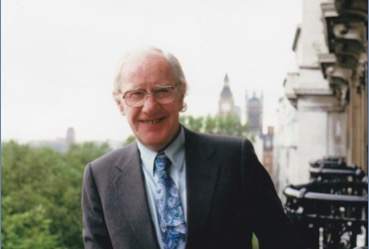

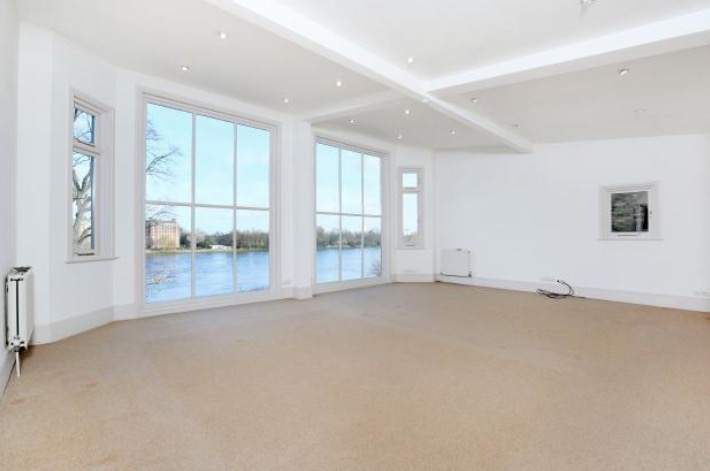
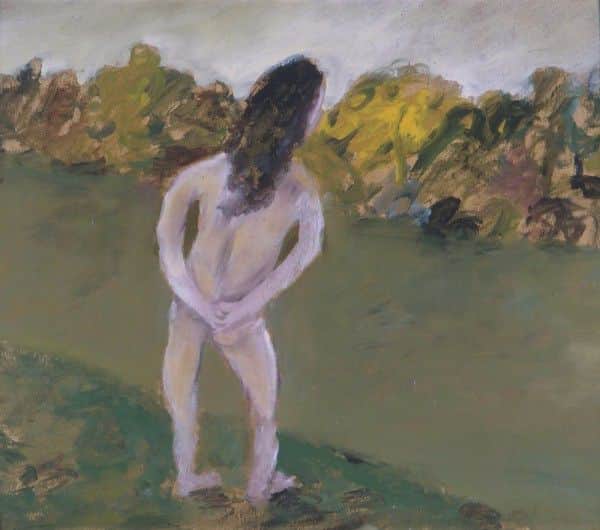



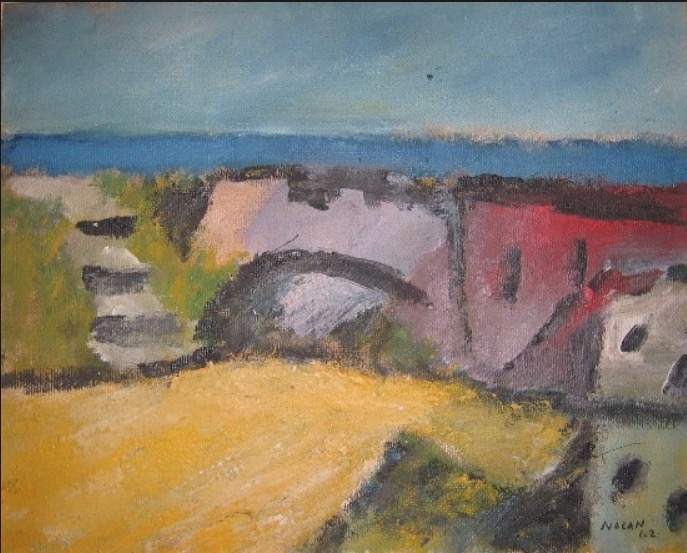
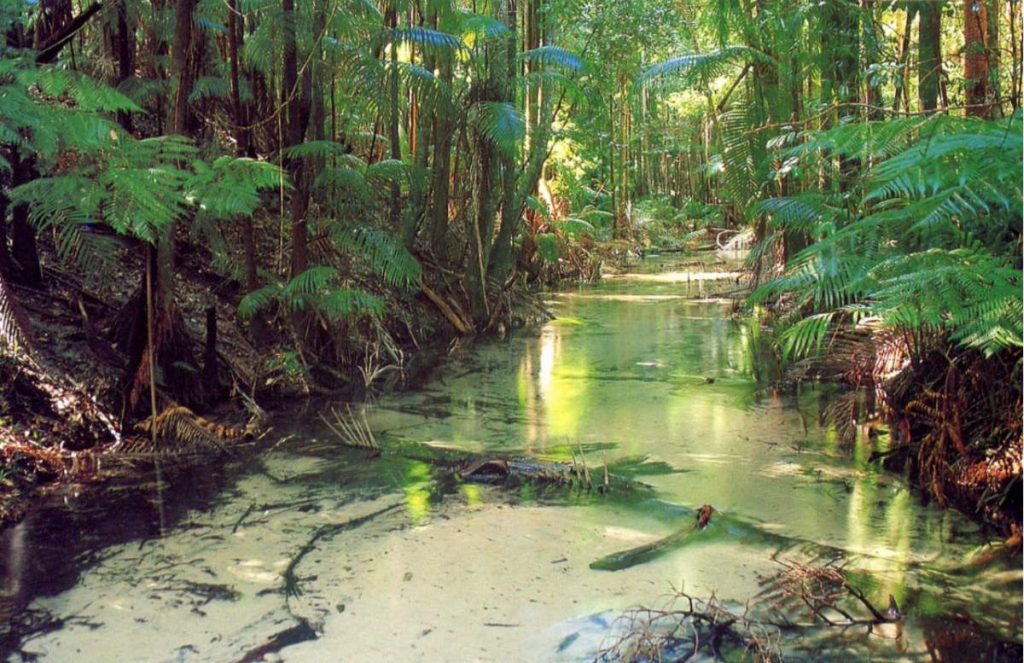
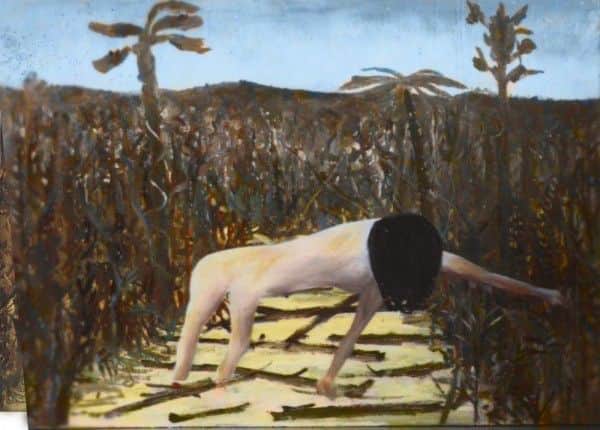
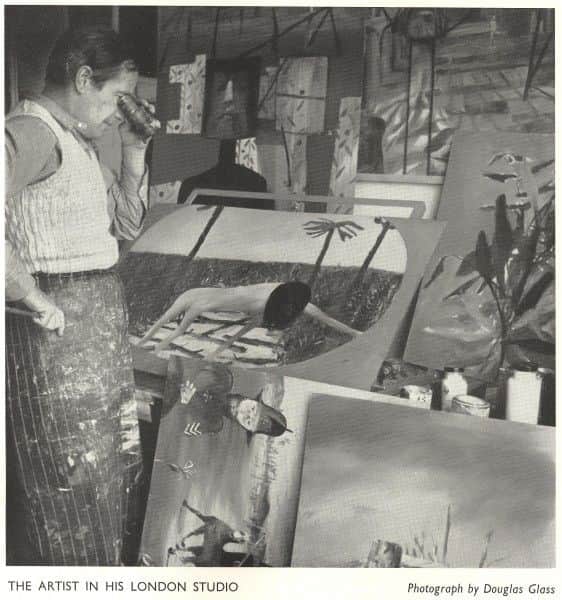

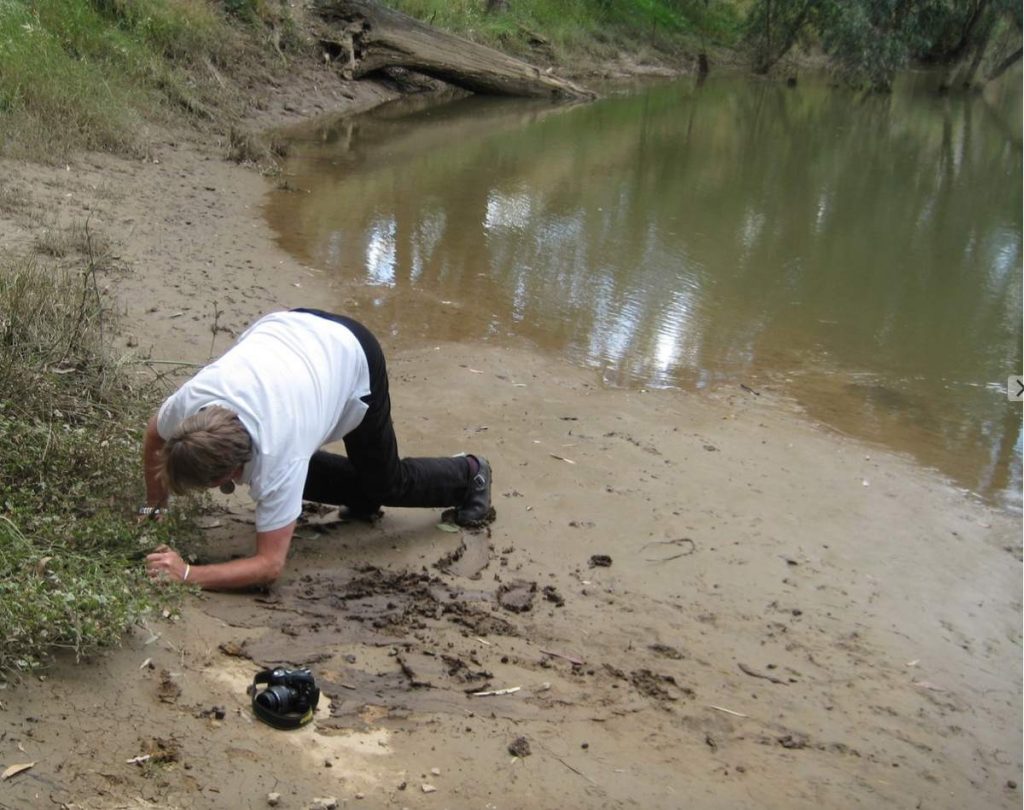
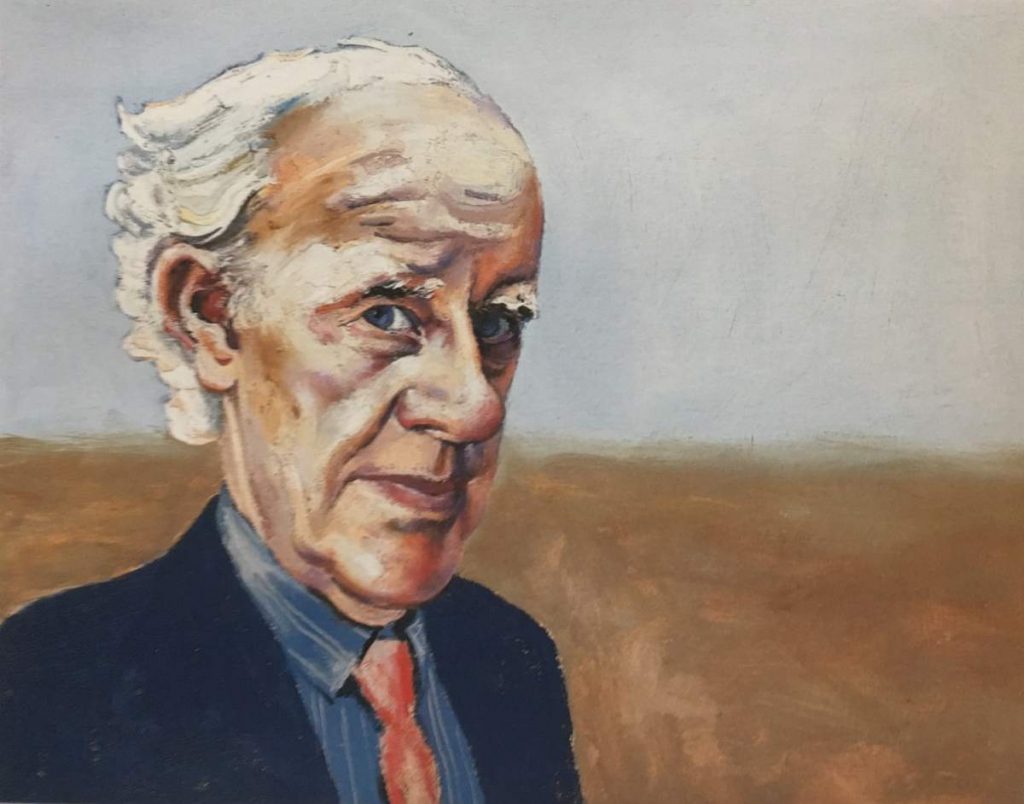

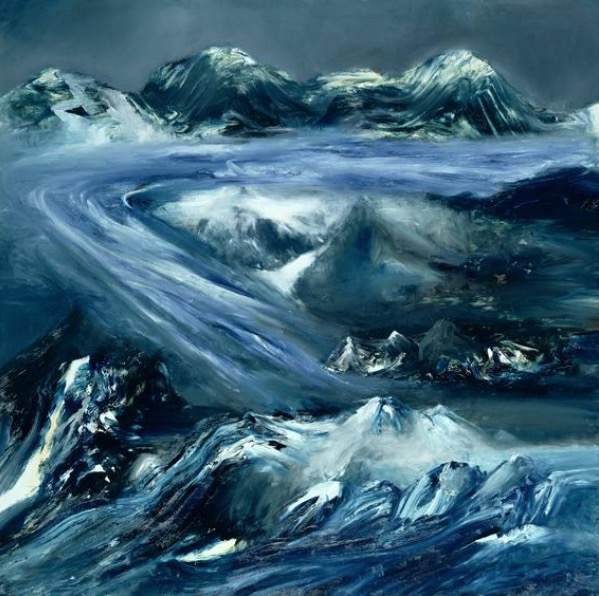
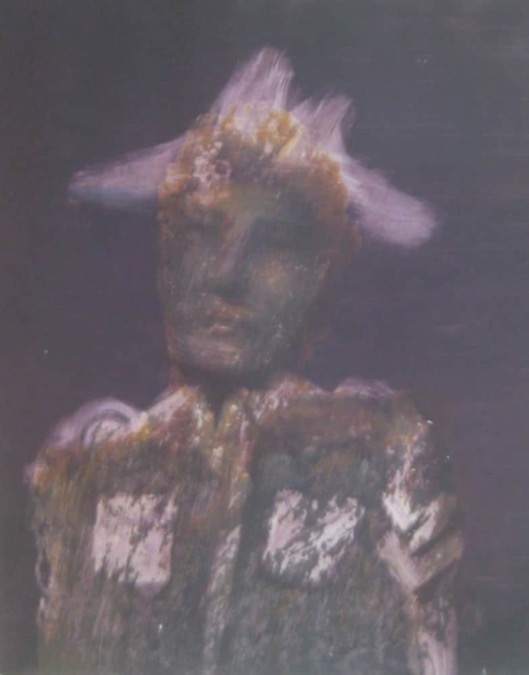
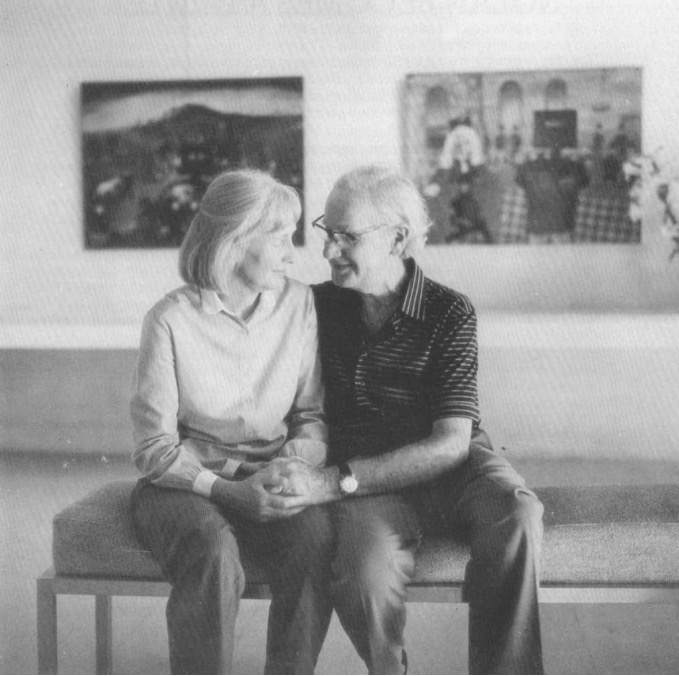
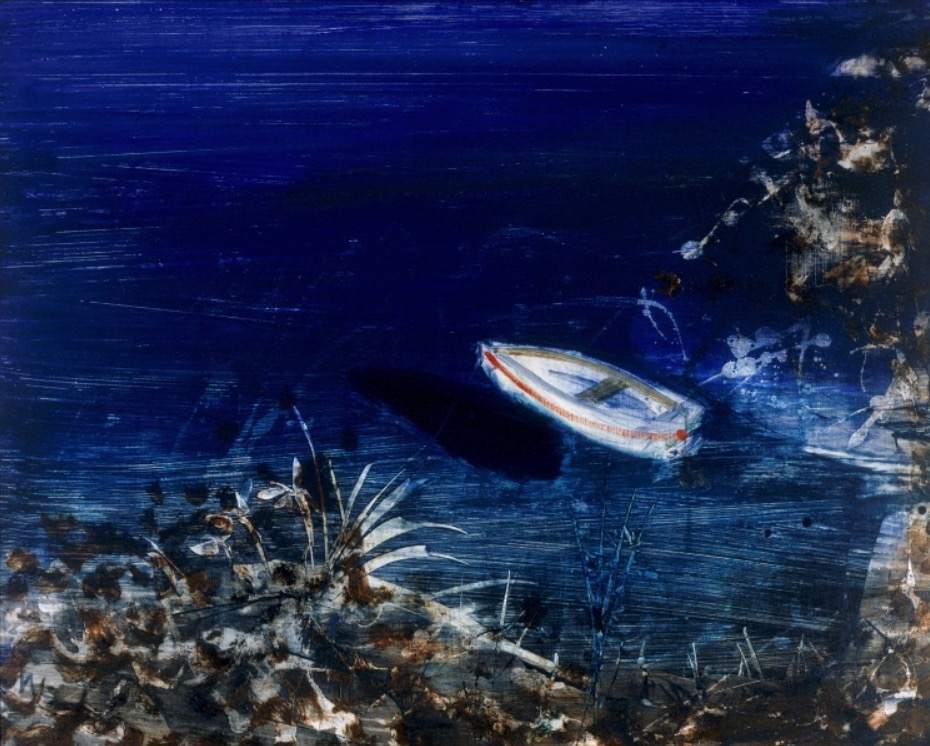

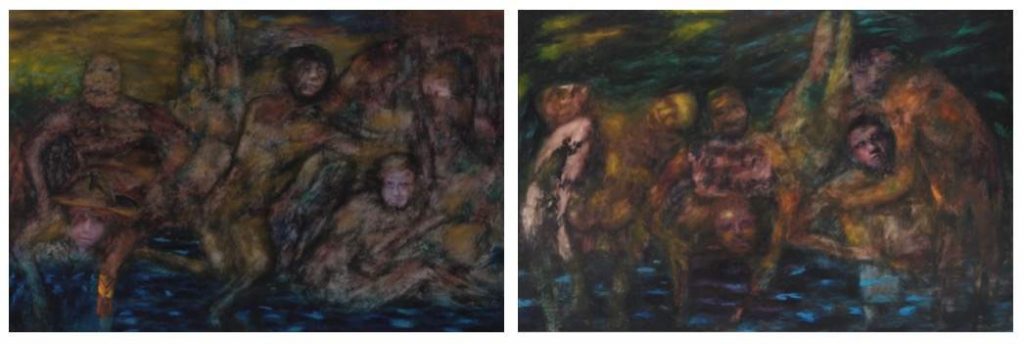

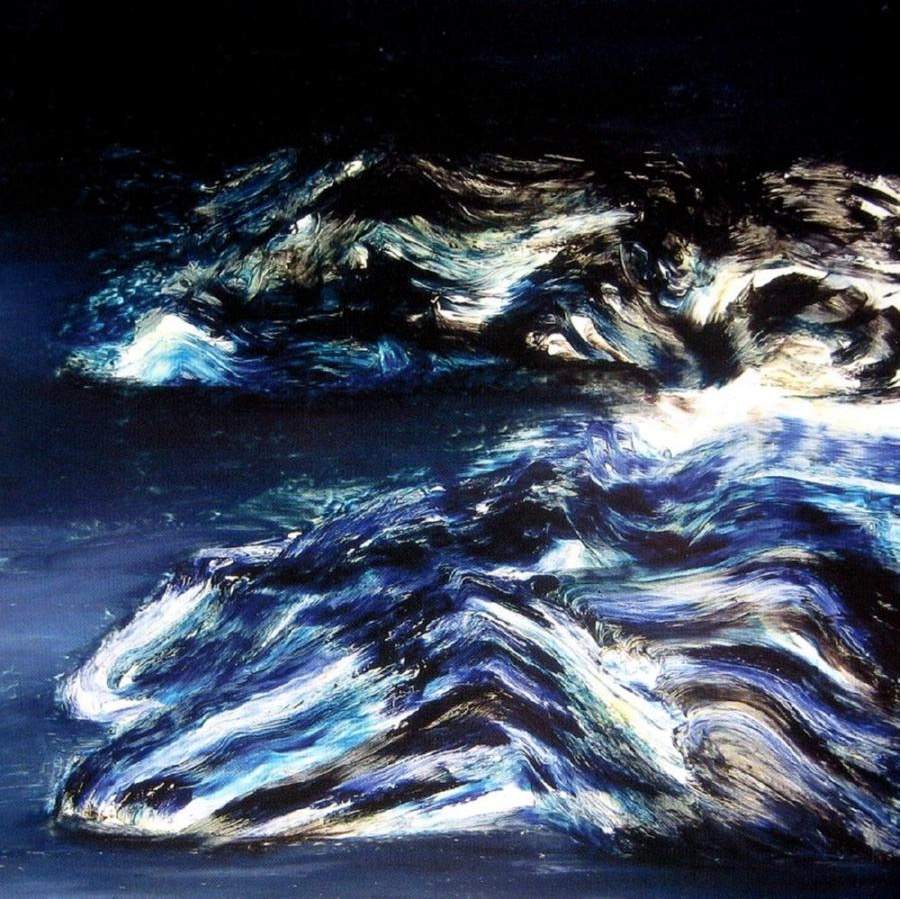

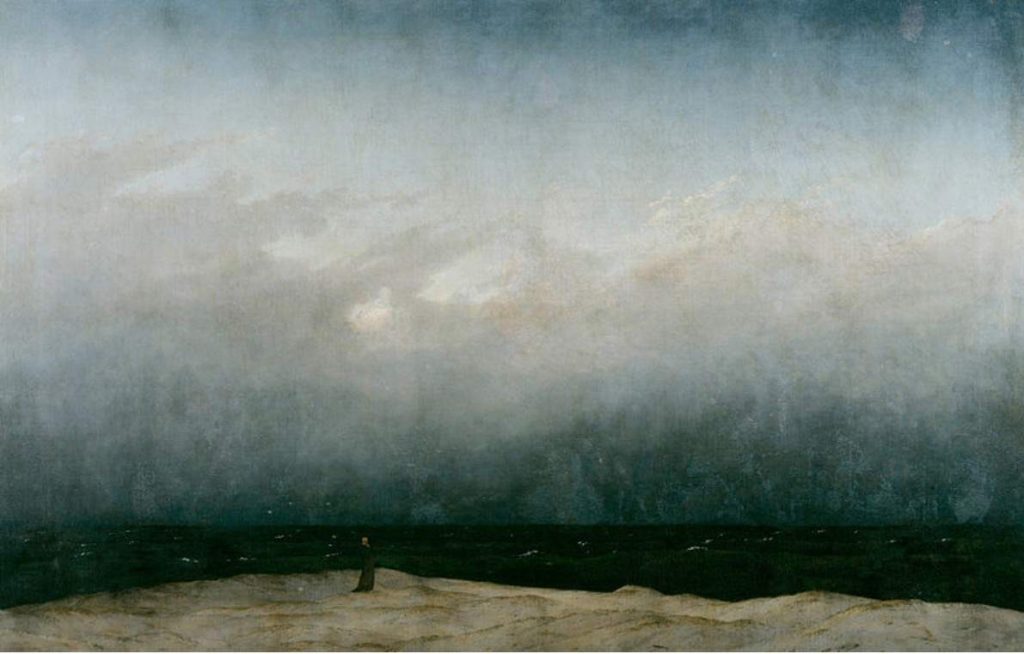

Great tribute, great resource.
Sir Sid is a big subject.
I kind of grew up with him through my parents‘ interest.
But been a while since I looked, then just found Rosenthal’s book in my library.
Sid’s secret was being half mad, born with a wild streak, the impulsive as a muse.
Thus i just read he tried with a mate to stowaway to England, made it to Queenscliff!
So the mad streak fed his creativity, so he ranged much further than his brother in law Arthur.
So left a vast oeuvre. Maybe it didn‘t always work. But who knows. Different generations bring their own perspectives.
I can now relate to Putney too. That’s funny. Through a daughter married and living at Battersea. Know that rail bridge, those riverflats. The pubs, like where Donald Pleasance lived.
Thanks, i will now read more.
William E.